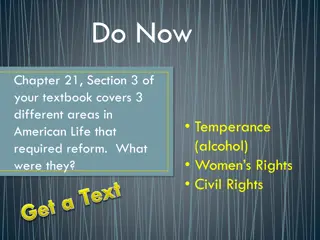The Temperance Movement in 19th Century America
The Temperance Movement emerged in the early 19th century in America, advocating for abstinence from alcohol due to its detrimental effects on health, families, and society. Led by figures like Lyman Beecher and Amelia Bloomer, the movement saw a decline in alcohol consumption, the implementation of alcohol prohibition laws in several states, and educational efforts focused on alcoholism. It also intertwined with the social and political landscape of Jacksonian Democracy, reflecting the changing attitudes towards alcohol and its impact on society.
Download Presentation

Please find below an Image/Link to download the presentation.
The content on the website is provided AS IS for your information and personal use only. It may not be sold, licensed, or shared on other websites without obtaining consent from the author.If you encounter any issues during the download, it is possible that the publisher has removed the file from their server.
You are allowed to download the files provided on this website for personal or commercial use, subject to the condition that they are used lawfully. All files are the property of their respective owners.
The content on the website is provided AS IS for your information and personal use only. It may not be sold, licensed, or shared on other websites without obtaining consent from the author.
E N D
Presentation Transcript
Temperance Movement BY: ASHLEY SUH, CRISTINA PREZIOSI, MACKENZIE BROWER
Background Info/Description Causes of the movement: What is the Temperance Movement? A social movement in the early 19th century that pushed people to reduce New immigrants, such as the Irish and Italians, were entering the U.S. The Irish and Italians had a lot of drinking of alcohol in their culture which heightened the amount of drinking in the U.S. to a certain extent This movement criticized the use of alcohol and promoted complete and even abstain from the intake of alcohol or other distilled beverages Since the end of the American Revolution, it became common for Americans to excessively drink alcohol because of the many economic and social problems of the country Another word for complete abstinence is teetotalism abstinence, or the absolute prohibition of alcohol Alcohol was seen as healthier to drink than water because most water sources were contaminated their husbands drinking This movement was pushed for by women who s families suffered from There was an increase of violence in families from the men coming home drunk which fueled women to emerge as supporters of temperance Many men would get a pay check after work and would go to bars to drink, spending all the money that they had to support their families Overall, alcohol and distilled beverages led to problems in health, destitution, crime, and violence
Important Leaders Lyman Beecher A Presbyterian minister who preached about abstaining from alcohol Gave six thunderous sermons on temperance Did not like the idea of drinking in moderation Was anti-Catholic because some Catholic ceremonies involved the consumption of wine He preached about anti-slavery and had a lasting impact on his children, notably Harriet Beecher Stowe, a famous abolitionist Despite his pro-abolition stance, he was racist against African Americans and refused to let African Americans listen to his teachings Founder of the American Temperance Society which was established in 1826 in Boston, MA The American Temperance Society promoted abstinence from alcoholic beverages and millions of Americans took the pledge to abstain from alcohol Credited as the starter of the Second Great Awakening Amelia Bloomer A women s rights and temperance supporter Was the editor of the first women s newspaper, The Lily The Lily was a temperance journal Had a great influence over women
Accomplishments There was a decline in alcohol consumption in the 1860s Schools started to teach about the effects of alcoholism Alcohol prohibition laws came into effect in several states, such as Maine
Connection to Jacksonian Democracy Quotes: The same Power that brought the slaves out of bondage will, in His own good time and way, bring about the emancipation of women, and make her equal in power and dominion that she was in the beginning. Bloomer The cult of domesticity from Jacksonian Democracy was challenged during the temperance movement by Amelia Bloomer. She wrote The Lily , her temperance newspaper. By writing this newspaper, Bloomer shows the dangers of men drinking and how it threatens the woman and children in their family. Since women couldn t vote because of this cult of domesticity , Bloomer is showing her expression in government through writing, which also goes back to the idea of the Rise of the Common Man . Amelia Bloomer gained more women supporters as more women read her newspaper. Women eat, they drink, they sleep, they dress, they dance and at last they die, without having accomplished the great purposes of their creation. Bloomer s salutary article in the Western Home Visitor
Multiple Choice Questions Lyman Beecher did all of the following things EXCEPT: a) Preach about temperance b) Start the American Temperance Society c) Preach about the flaws and prohibition of immigration d) Promote the prohibition of distilled beverages
Multiple Choice Questions The American Temperance Society was: a) An organization that supported women s rights and the prohibition of abolition b) An organization that supported abolitionist movements and supported temperance c) An organization that promoted alcoholism and caused the Second Great Awakening d) An organization that promoted temperance and teetotalism
Multiple Choice Questions The Temperance Movement was MOSTLY supported by: a) Presbyterian ministers and anti-Catholics b) Women c) Free African Americans d) Jacksonian democrats























